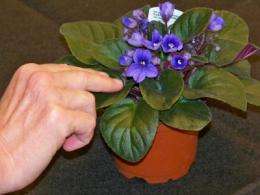For African violets, 'hands off' means healthier

African violets have a mixed reputation. Their delicate, colorful flowers and furry, soft leaves make them a favorite among home gardeners and growers. But the striking plants are often regarded as temperamental: a precise recipe of light, moisture, warm temperatures, high humidity, and fertilizer is required to encourage african violets to grow and flower.
A recently published study by scientists Julia C. Brotton and Janet C. Cole from the Department of Horticulture and Landscape Architecture at Oklahoma State University (in a recent issue of HortTechnology) could provide african violet enthusiasts with important care information about the finicky flower.
Because of their brightly colored flowers and hairy leaves, people are attracted to african violets and often want to touch the leaves and flowers. But how does all this attention affect the plants? The research team set out to determine the effect of "brushing" african violet leaves on plant growth and quality. Cole explained, "Because (african violet) growers work in conditions that can contribute to the development of dry, irritated skin, many growers use body lotions to help soothe and moisturize their dry skin. Many consumers also use these products. Our study researched whether touching or "brushing" african violet leaves causes damage, particularly when body lotion or other skin care products have been applied to hands before touching the plants."
Although previous studies have investigated the effect of various methods of mechanical conditioning, including brushing, on the growth and quality of vegetable and bedding plants, this was the first reported study of the results of plant response to tactile mechanical stress, or "thigmomorphogenesis" on african violets.
Plants of two cultivars of african violet (Saintpaulia ionantha), 'Michigan' and 'Gisela', received five brushing treatments during the study: no brushing, brushed for 30 seconds with a latex-gloved hand, brushed for 90 seconds with a latex-gloved hand, brushed for 30 seconds after applying lotion to a nongloved hand, and brushed for 90 seconds with lotion on the nongloved hand.
After five weeks the plants were harvested. At harvest, plants were rated on a scale of 1 to 5 (no damage - dead/near dead). Plants that were brushed by a gloved hand had lower damage ratings, greater leaf areas, and greater leaf numbers than plants that were brushed with a nongloved hand to which lotion had been applied. The cultivars varied in their response, with 'Michigan' exhibiting more damage from brushing than 'Gisela'
Summarizing the results, Cole remarked that "the study suggests that repeated brushing reduces plant size and quality of african violets, particularly when done with a bare hand to which lotion has been applied. Brushing leaves of african violets is not recommended because repeated brushing can decrease plant quality and size."
The next time you are tempted to touch that pretty african violet in your kitchen window, remember— for a healthier plant, keep your hands off!
Source: American Society for Horticultural Science
















